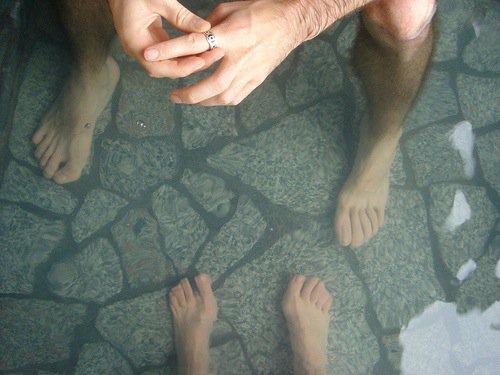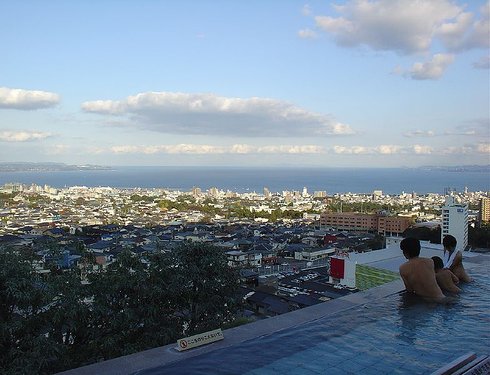Super Sento
Tokyo life can certainly be stressful. The city is so full of people everywhere it can make big cities in other countries seem like ghost towns. And with a long-hours culture in which salary-men can work more than 12 hours a day, Tokyoites need some way of letting off steam and relaxing. One of the most popular solutions to this problem has become the Super Sento – otherwise known as hanging out with your friends in the nude. Well, there’s a bit more to it than that. At the reception desk you’ll be given some kind of casual kimono, or some pyjamas, and a locker key. Get changed into these – leaving all your other possessions in the locker room, and head inside. You’re now in a world where you have left all the hustle and bustle of the city behind. Everything is quiet and peaceful, everyone moves slowly and talks in hushed tones.
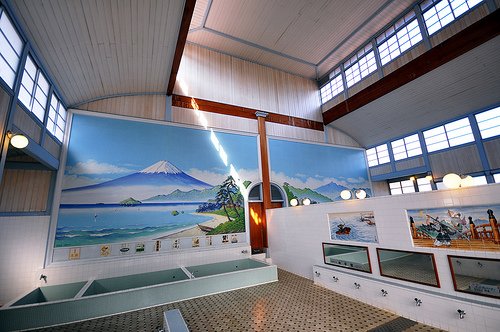
A traditional (non-super) Tokyo sento. Bathers wash at the taps in front of the mirrors, before entering the tubs at the back of the room. The wall on the right divides the men’s and women’s sides
Now a sento is a bathhouse – so get ready to get wet. Men and women will have to split up at this stage and head for their respective sides. Enter another locker room – but this time just strip off instead of changing into anything else, and walk through the glass doors completely naked.
Don’t worry if this breaks several deeply ingrained taboos – this is Japan and the usual rules don’t apply over there. Then sit down on a stool and shower thoroughly (yes – you never stand up in the shower in Japan – and no-one wants your sweat and dirt in the bath, so you better make a show of doing a good job).
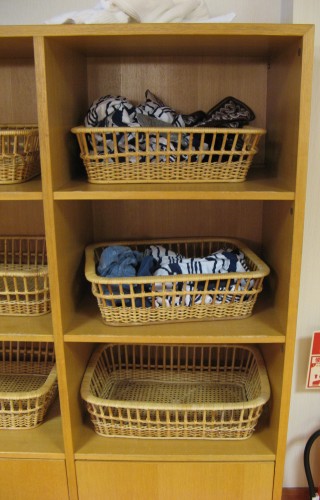
The low-security approach to clothes storage is evidence of Japan’s low crime rate, but in a modern super-sento you’re more likely to encounter lockers than traditional baskets like these
Now you’re ready to explore the baths themselves. There’s usually a range of tubs varying from hot, to very hot, to near-scalding. It’s best to cautiously stick your toe in first and edge in very gently. Once in you can just relax, or maybe strike up a conversation with the naked stranger next to you. Most super-sento will include a sauna, some outdoor baths on the rooftop, and perhaps some special baths with bubble jets or ones containing red-wine or tea instead of water. Depending on when and where you go there might be lots of naked children running around without a care in the world – a sure sign that Japan has a much more relaxed attitude to nudity than we’re used to at home.
Once you’ve boiled as long as you can stand it (beware of fainting from the heat), head back to the locker room and retrieve your pyjamas. Now you can rejoin any companions of the opposite sex and explore the other facilities together. You can grab a drink in the bar, a snack in the restaurant, dabble your feet in the rooftop footbaths, or take a nap in the warm relaxation room – essentially a low-temperature sauna where you get to keep your clothes on. Once you’ve chilled a bit you might think about heading for another dip in the baths, or perhaps having a massage or body scrub. One of the wonders of super sentos is that they are timeless places, where hours can pass before you realize it. They’re dotted all over Tokyo, and are usually open all night as well – so you could use one as a cheap substitute for a hotel.
Access and Web: One of the best Super Sento is Yutopia next to JR Ogikubo station. Take the orange Chuo Line Rapid train from Shinjuku Station (11 minutes) or Tokyo Station (24 minutes). Toshimaen Niwa no Yu, with outdoor baths in the garden, is another great option, 2 minutes walk from Toshimaen Station on the Oedo Line from Shinjuku station (18 minutes). Most convenient of all is La Qua, right in the middle of Tokyo, near Suidobashi Station on the Chuo-Sobu line. Niwa no Yu and La Qua both have restrictions on children’s admission, depending on their age and the time of day.
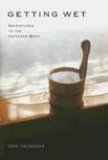 Getting Wet: Adventures in the Japanese Bath
by Eric Talmadge.
Written from a personal perspective, by a knowledgeable admirer of the Japanese approach to getting clean, this book chronicles a host of personal experiences in the full range of tubs. The geographical spread of his aqueous adventures is impressive – ranging from volcanic islands far out to sea, to mountain villages in the heart of Japan, even to Tokyo’s infamous ‘soaplands’, where a young lady will assist you with your bathing ritual. This is all backed up with solid coverage of the history of bathing in Japan, and an investigation into just how well founded are the claims of healing properties frequently attributed to natural hot spring baths.
Getting Wet: Adventures in the Japanese Bath
by Eric Talmadge.
Written from a personal perspective, by a knowledgeable admirer of the Japanese approach to getting clean, this book chronicles a host of personal experiences in the full range of tubs. The geographical spread of his aqueous adventures is impressive – ranging from volcanic islands far out to sea, to mountain villages in the heart of Japan, even to Tokyo’s infamous ‘soaplands’, where a young lady will assist you with your bathing ritual. This is all backed up with solid coverage of the history of bathing in Japan, and an investigation into just how well founded are the claims of healing properties frequently attributed to natural hot spring baths.
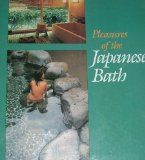 Pleasures of the Japanese Bath
by Peter Grilli.
A great book, that explores the important role of baths in Japanese society past and present. The author is so passionate about Japan’s approach to bathing, that he goes so far as to describe it as a religion. His in depth knowledge of the subject is demonstrated by the many first-hand accounts of his own bathing experiences, and the hundreds of hot springs he recommends. The book covers the full range of bathing experiences, from idyllic wooden tubs in the remote countryside, to functional inner-city bathhouses for everyday use, and comes complete with plenty of photographs and illustrations.
Pleasures of the Japanese Bath
by Peter Grilli.
A great book, that explores the important role of baths in Japanese society past and present. The author is so passionate about Japan’s approach to bathing, that he goes so far as to describe it as a religion. His in depth knowledge of the subject is demonstrated by the many first-hand accounts of his own bathing experiences, and the hundreds of hot springs he recommends. The book covers the full range of bathing experiences, from idyllic wooden tubs in the remote countryside, to functional inner-city bathhouses for everyday use, and comes complete with plenty of photographs and illustrations.
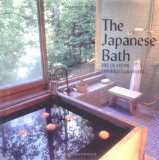 The Japanese Bath
by Yoshiko Yamamoto and Bruce Smith.
This book delves into what makes a perfect Japanese bath – the ideal space for soothing nerves and boosting vitality. This is illustrated with abundant photos, both of small private and large communal baths, but the book’s focus is on the philosophy of baths. It explains how many aspects of the bathing process blend together to create an exquisite sensual experience.
The Japanese Bath
by Yoshiko Yamamoto and Bruce Smith.
This book delves into what makes a perfect Japanese bath – the ideal space for soothing nerves and boosting vitality. This is illustrated with abundant photos, both of small private and large communal baths, but the book’s focus is on the philosophy of baths. It explains how many aspects of the bathing process blend together to create an exquisite sensual experience.
 Japan’s Hidden Hot Springs
by Robert Neff.
An enthusiast’s guide to the best out-of-the-way hot spring baths in Japan. If you want to get off the beaten track, and away from places usually patronized by foreign visitors, this book will help you find an idyllic onsen-ryokan in a serene natural setting. But be warned that the author has expensive tastes.
Japan’s Hidden Hot Springs
by Robert Neff.
An enthusiast’s guide to the best out-of-the-way hot spring baths in Japan. If you want to get off the beaten track, and away from places usually patronized by foreign visitors, this book will help you find an idyllic onsen-ryokan in a serene natural setting. But be warned that the author has expensive tastes.
 How to Take a Japanese Bath
by Leonard Koren.
A bit of an oddity this one, but worth considering. It’s certainly much less useful and more interesting than the title would suggest. It consists of a series of illustrations that really do tell you how to take a bath, but what makes it worthwhile buying is not the practical information, but the way it succeeds in communicating the essence of Japan’s bathing philosophy through a few simple illustrations and a sprinkling of carefully chosen words. Perhaps a bit expensive for what it is, but if you’re attracted to the esoteric, it may well be for you.
How to Take a Japanese Bath
by Leonard Koren.
A bit of an oddity this one, but worth considering. It’s certainly much less useful and more interesting than the title would suggest. It consists of a series of illustrations that really do tell you how to take a bath, but what makes it worthwhile buying is not the practical information, but the way it succeeds in communicating the essence of Japan’s bathing philosophy through a few simple illustrations and a sprinkling of carefully chosen words. Perhaps a bit expensive for what it is, but if you’re attracted to the esoteric, it may well be for you.
 Sento – The Japanese Public Bath
by Elizabeth Ishiyama.
I haven't actually read this book, nor do I know anything about it, but it was the only book I could find specifically on sento – so buy it at your own risk.
Sento – The Japanese Public Bath
by Elizabeth Ishiyama.
I haven't actually read this book, nor do I know anything about it, but it was the only book I could find specifically on sento – so buy it at your own risk.


